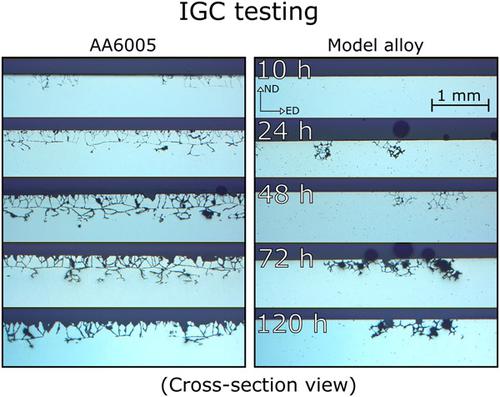当前位置:
X-MOL 学术
›
Mater. Corros.
›
论文详情
Our official English website, www.x-mol.net, welcomes your feedback! (Note: you will need to create a separate account there.)
Comparing intergranular corrosion in Al‐Mg‐Si‐Cu alloys with and without α‐Al(Fe,Mn,Cu)Si particles
Materials and Corrosion ( IF 1.8 ) Pub Date : 2020-09-28 , DOI: 10.1002/maco.202011954 Adrian Lervik 1 , Turid Danbolt 2 , Trond Furu 2, 3 , Randi Holmestad 1 , Otto Lunder 2, 4
Materials and Corrosion ( IF 1.8 ) Pub Date : 2020-09-28 , DOI: 10.1002/maco.202011954 Adrian Lervik 1 , Turid Danbolt 2 , Trond Furu 2, 3 , Randi Holmestad 1 , Otto Lunder 2, 4
Affiliation

|
In this study, a model alloy without Fe and Mn additions, is compared with a commercial AA6005 alloy to further understand how the α‐Al(Fe,Mn,Cu)Si particles affect intergranular corrosion (IGC) behaviour. Both alloys were subjected to an accelerated IGC test for durations ranging from 1 to 120 h. Microstructures were studied using scanning and transmission electron microscopy, and electron backscatter diffraction. The presence of α‐Al(Fe,Mn,Cu)Si particles yields significantly more uniform IGC attacks and higher corrosion rates. However, the maximum depth of IGC attacks reaches similar values after ~24 h of exposure. This is attributed to the formation of Cu‐rich particles along the grain boundaries during the corrosion process, which further catalyses the cathodic reactions.
中文翻译:

比较有无Al-Al(Fe,Mn,Cu)Si颗粒的Al-Mg-Si-Cu合金的晶间腐蚀
在这项研究中,将不添加铁和锰的模型合金与商用AA6005合金进行了比较,以进一步了解α-Al(Fe,Mn,Cu)Si颗粒如何影响晶间腐蚀(IGC)行为。两种合金都经过IGC加速试验,持续时间为1至120小时。使用扫描和透射电子显微镜以及电子反向散射衍射研究了微观结构。α-Al(Fe,Mn,Cu)Si颗粒的存在会产生更均匀的IGC腐蚀和更高的腐蚀速率。但是,暴露约24小时后,IGC攻击的最大深度达到相似的值。这归因于在腐蚀过程中沿晶界形成富铜颗粒,这进一步催化了阴极反应。
更新日期:2020-09-28
中文翻译:

比较有无Al-Al(Fe,Mn,Cu)Si颗粒的Al-Mg-Si-Cu合金的晶间腐蚀
在这项研究中,将不添加铁和锰的模型合金与商用AA6005合金进行了比较,以进一步了解α-Al(Fe,Mn,Cu)Si颗粒如何影响晶间腐蚀(IGC)行为。两种合金都经过IGC加速试验,持续时间为1至120小时。使用扫描和透射电子显微镜以及电子反向散射衍射研究了微观结构。α-Al(Fe,Mn,Cu)Si颗粒的存在会产生更均匀的IGC腐蚀和更高的腐蚀速率。但是,暴露约24小时后,IGC攻击的最大深度达到相似的值。这归因于在腐蚀过程中沿晶界形成富铜颗粒,这进一步催化了阴极反应。



























 京公网安备 11010802027423号
京公网安备 11010802027423号